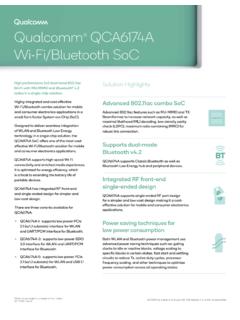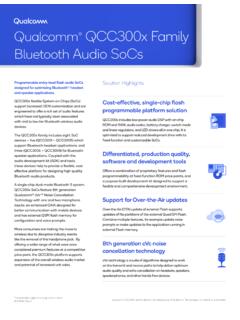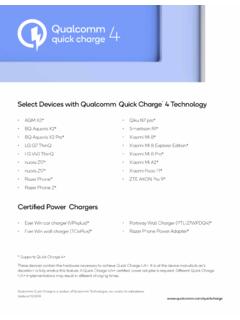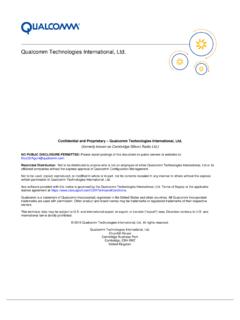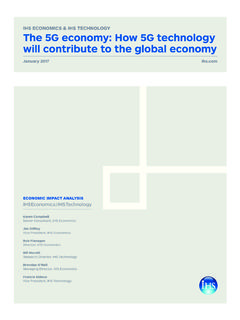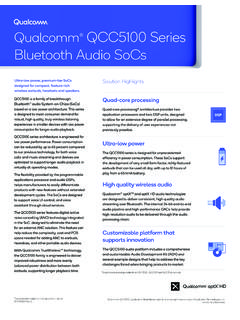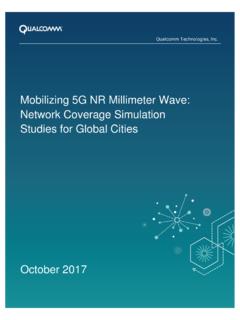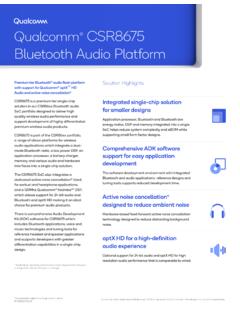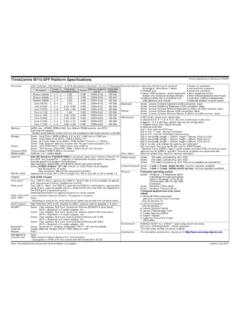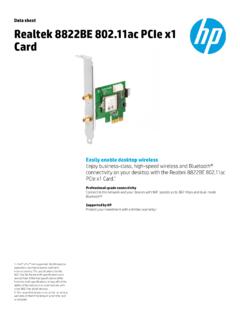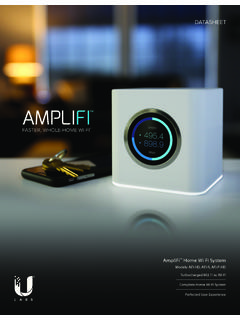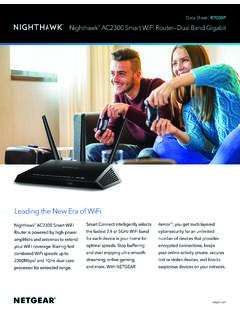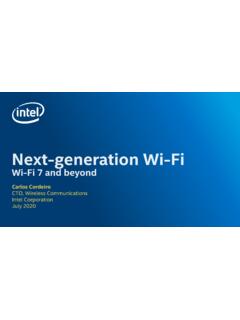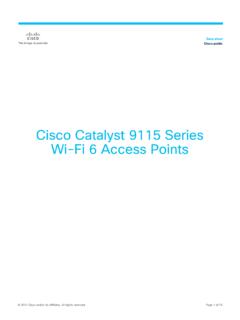Transcription of The Ultimate Wi-Fi Access Point: Which Wi-Fi 6 Features ...
1 RF & Wireless June 2019 Christopher Taylor Report Snapshot Strategy Analytics examined Features in premium tier, high-performance Wi-Fi 6 Access points through discussions with testing labs, OEMs, carriers, and chipset providers. Although marketing messages have typically promoted OFDMA as the main feature of Wi-Fi 6, we found that 8 x 8 MU-MIMO provides the biggest benefit to total system throughput and capacity. RF & Wireless Components (RFWC)RF & Wireless Components (RFWC) The Ultimate Wi-Fi Access Point: Which Wi-Fi 6 Features Define the New Premium Tier? RF & Wireless Copyright Strategy Analytics 2019 | 2 of 24 Contents 1. Executive Summary 3 2. Analysis 3 Goals 3 Wi-Fi 6 Background 4 Project Statistics 9 Attractive Wi-Fi 6 Features in the Premium Tier 10 Myths Surrounding MU-MIMO 13 The Industry View of Wi-Fi 6 Product Positioning 14 Why Upgrade to Wi-Fi 6 Now?
2 15 Wi-Fi 6 Forecast 16 3. Implications 18 4. Appendix 20 5. How Can We Help You? 24 Exhibits Exhibit 1 The Wi-Fi Performance Envelope .. 4 Exhibit 2 MU-MIMO Clients and Stations .. 6 Exhibit 3 Theoretical System Data Rate vs. Number of Clients with MU-MIMO .. 7 Exhibit 4 Beamforming .. 7 Exhibit 5 OFDMA Compared to OFDM .. 8 Exhibit 6 Network Capacity vs. Number of Clients, OFDMA vs. OFDM .. 9 Exhibit 7 Premium-tier APs Announced and In Development .. 10 Exhibit 8 Typical Wi-Fi 6 AP Product Portfolio .. 12 Exhibit 9 Wi-Fi 6 8 x 8 MU-MIMO Motions Tests .. 13 Exhibit 10 Industry View of Product Positioning .. 15 Exhibit 11 Wi-Fi 6 Release Modes .. 16 Exhibit 12 Wi-Fi Forecast by Standard .. 17 Exhibit 13 Wi-Fi Forecast by Application .. 18 Exhibit 14 Publicly Announced Wi-Fi 6 APs with 8 x 8 MU-MIMO at 5 GHz.
3 20 Exhibit 15 Publicly Announced Wi-Fi 6 APs with Dual-band and Tri-band 4 x 4 .. 22 RF & Wireless Copyright Strategy Analytics 2019 | 3 of 24 1. Executive Summary Wi-Fi 6 significantly enhances wireless performance across multiple vectors, providing a new and improved user experience as compared to earlier versions of Wi-Fi . To accomplish this, Wi-Fi 6 uses wholly new technologies and methods, some from the cellular world, to efficiently deliver more capacity to more devices. This increased capacity and efficiency reduces congestion for a faster, more robust, and higher quality user experience in dense deployments. Wi-Fi 6 comes with a host of new Features , and here we ll focus on those of highest significance in defining the premium experience. While Wi-Fi 6 is expected to ramp very quickly across many market segments and tiers, this report particularly focuses on understanding how the most advanced implementations will be defined.
4 Among the Features discussed, 8 x 8 MU-MIMO stands out as providing the most significant benefits to total system performance aligned with the promises of Wi-Fi 6. 2. Analysis Goals This analysis of Wi-Fi 6 Features in premium Access points should serve to guide the expectations of consumers and manufacturers alike. Wi-Fi 6, the Wi-Fi Alliance designation for the next-generation standard , will follow , leading to higher-performance Wi-Fi and a better user experience. Wi-Fi 6, as with any other major wireless technology transition, is expected to broadly deploy across nearly every application where Wi-Fi is found today, and in new applications as well. This report seeks to define the premium tier feature set for network infrastructure applications, where the highest possible performance expectations will require the fullest and most robust implementation of Wi-Fi 6.
5 To best understand Which Features define this highest performance tier, the author sought out insights from a representative sample of industry sources as indicators in preparing this report: Testing labs, Which have early Access and deep insights to silicon provider s chips to develop test equipment, as well as Access to OEM s devices for testing. Testing labs can help to confirm actual device performance vs. theoretical. Testing labs the author contacted included Airgain, Cetacom, Deka, dot11labs, NTS, UNH, OctoScope (testbeds), and Spirent. OEMs of residential Access points (APs), who tune performance criteria to consumer purchasing decisions. OEMs of enterprise APs, who look for much more extreme configurations than residential OEMs, with client counts in the hundreds, and with advanced software and hardware requirements.
6 Enterprise IT departments value robust APs with enhanced link budgets, adaptability to interference, analytics for Access control, application policy & network security, and multi-site management capabilities. RF & Wireless Copyright Strategy Analytics 2019 | 4 of 24 Carriers (internet service providers or ISPs) that offer Wi-Fi Gateways to customers. Requirements may more closely resemble either residential or enterprise OEMs depending on the needs of the infrastructure installation. For example, in more complex installations, carriers can benefit from management functions similar to those used in enterprise Wi-Fi when these functions can reduce installation or troubleshooting time and improve consumer satisfaction. Strategy Analytics also conducted informal discussions with Wi-Fi chipset providers to gain their perspectives on necessary Features and planning for Wi-F 6 APs.
7 The author anticipated that the highest possible performance Features would apply to premium tier APs, potentially from enterprise OEMs, and that mid- and low-tier APs might have a different mix or emphasis on Features . All participants in discussions were given anonymity unless requesting otherwise. Wi-Fi 6 Background Wi-Fi 6 addresses wireless performance across several vectors. Whereas Wi-Fi evolution has historically centered on the pursuit of higher peak data rates for a user (see Exhibit 1), Wi-Fi 6 achieves this through a completely different focus; Wi-Fi 6 was developed to increase both overall efficiency and capacity. This shift in priority from speed to capacity and efficiency aligns with the larger macro trends toward ever higher average data rates per device while networks contend with more devices and higher density deployments.
8 Exhibit 1 The Wi-Fi Performance Envelope RF & Wireless Copyright Strategy Analytics 2019 | 5 of 24 Wi-Fi 6 is perhaps the most auspicious feature update to Wi-Fi ever undertaken by the Wi-Fi Alliance and industry. With scores of Features in draft, below are considered some of the most essential to achieving higher efficiency and capacity under Wi-Fi 6: Eight spatial streams in the 5 GHz band, in conjunction with four spatial streams in the GHz band, yields up to 12 streams of Wi-Fi 6 connectivity, significantly boosting overall spectrum use. MU-MIMO uses spatial multiplexing to increase the number of simultaneous users of the same frequency resources, increasing capacity ( system throughput), time efficiency and spectral efficiency. With 12 spatial streams available for MU-MIMO instead of four, this is a big upgrade for Wi-Fi 6 over Wi-Fi 5.
9 OFDMA reduces overhead and contention, reduces packet-to-packet latency, and increases efficiency in congested conditions. OFDMA splits the total available spectrum among client devices. Triggering. A Wi-Fi 6 Access point uses triggers to inform client devices how to make use of time and frequency resources, modulation, coding and spatial streams to minimize contention and improve capacity. Wi-Fi 6 can split bandwidth among low data rate clients, it can use spatial diversity with MU-MIMO to increase overall bandwidth, and it can do both in combination, a defining attribute of Wi-Fi 6. Other important Features : 1024-QAM is a higher-order modulation that delivers increased throughput. Spatial reuse enhances Wi-Fi coexistence with other, nearby Wi-Fi networks. Target Wake Time (TWT) reduces power consumption.
10 20-MHz-only channels allows IoT sensors to use spectrum more efficiently. Wi-Fi 6 extends the new Features to the congested GHz band. Most Wi-Fi 6 marketing activity has concentrated on OFDMA, but this report will look at another feature first, multi-user MIMO. Introduced to Wi-Fi in , Wi-Fi 6 further extends MU-MIMO, increasing the number of simultaneous users for higher system capacity, time and spectral efficiencies: In Wi-Fi 6, MU-MIMO can make use all 12 spatial streams in both the uplink (UL) and downlink (DL) directions. Wi-Fi 5 ( ) can use MU-MIMO only in the 5 GHz band, with MU-MIMO in the DL direction only. In Wi-Fi 6, an Access point can exploit as many as eight spatial streams in the 5 GHz band using eight antennas to simultaneously address eight 1 x 1 client devices or four 2 x 2 client devices.
